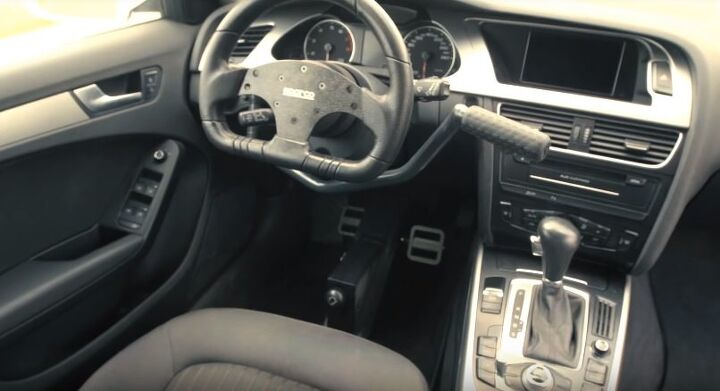It's Always Leg Day in This Pedal-powered Audi A4 Avant

It’s an idea that seems stupid and brilliant all at once, and a Dutch firm wants it to find a home in Europe’s passenger cars.
Europeans, often portrayed in films as sexy people with a penchant for rich foods and impeccably fashionable clothing, aren’t immune from the sedentary lifestyles and obesity afflicting their Western compatriots. Commutes eat up a lot of time, and not everyone bikes or takes a train to work — even in insufferably progressive Amsterdam.
Following a request from an inventor looking to free up more exercise time during the day, Dutch engineering firm BPO set about converting an Audi A4 wagon to run on pedal power. The car’s turbo 2.0-liter four-cylinder still does the work, but it won’t work if the driver doesn’t break a sweat.
A profile in Wards Auto describes how inventor Nasser Al Shawaf compelled the firm to turn an Audi AV Avant into the FitCar PPV concept. BPO’s modifications aren’t brand-specific — the company wants anyone who feels trapped by a lengthy commute to have the ability to convert their own car to pedal power. You’ll just need an automatic transmission. Currently, BPO is waiting on European approval.
The setup strips out both pedals, relocating the brake to a steering column-mounted arm (like those used by people with mobility issues). In place of the accelerator is a bicycle-type mechanism that occupies the footwell. Pedalling the thing spins a flywheel, generating an electronic pulse to engage the accelerator. Pedal faster, and the car goes faster.
“I work in many cities around the world where a 60-minute-plus car commute each way, each day is not uncommon,” Al Shawaf said. “This is an unhealthy way to waste more than two hours every day. So I came up with the idea of the FitCar, which does exactly the same as any conventional car getting us safely and comfortably from A to B. However, in the FitCar you can exercise while you drive.”
The company claims there are three drive modes to accommodate low-speed traffic situations, high speed cruising, and sitting at rest (the driver/pedaller can disconnect at stoplights and in traffic jams to keep the workout going). Pedal resistance is also adjustable.
At first blush, it seems gimmicky and potentially dangerous. How is a driver supposed to respond instantly at times when an immediate foot-to-the-floor burst of speed is required? That’s unknown. Certainly, a video posted to YouTube by FitCar PPV shows a pretty leisurely cruise around a racetrack. The test car also contains a very flat bottomed racing wheel with no airbag to accommodate the driver’s busy legs.
Oscar Brocades Zaalberg, managing director of BPO, hopes that the EU gives its system the thumbs-up. He then hopes OEMs take note and offer the system as an option. It’s safe to say the individual modification route is a safer bet.
[Image: FitCar PPV/ YouTube]

More by Steph Willems
Latest Car Reviews
Read moreLatest Product Reviews
Read moreRecent Comments
- Dwford I don't think price is the real issue. Plenty of people buy $40-50k gas vehicles every year. It's the functionality. People are worried about range and the ability to easily and quickly recharge. Also, if you want to buy an EV these days, you are mostly limited to midsize 5 passenger crossovers. How about some body style variety??
- SCE to AUX The nose went from terrible to weird.
- Chris P Bacon I'm not a fan of either, but if I had to choose, it would be the RAV. It's built for the long run with a NA engine and an 8 speed transmission. The Honda with a turbo and CVT might still last as long, but maintenance is going to cost more to get to 200000 miles for sure. The Honda is built for the first owner to lease and give back in 36 months. The Toyota is built to own and pass down.
- Dwford Ford's management change their plans like they change their underwear. Where were all the prototypes of the larger EVs that were supposed to come out next year? Or for the next gen EV truck? Nowhere to be seen. Now those vaporware models are on the back burner to pursue cheaper models. Yeah, ok.
- Wjtinfwb My comment about "missing the mark" was directed at, of the mentioned cars, none created huge demand or excitement once they were introduced. All three had some cool aspects; Thunderbird was pretty good exterior, let down by the Lincoln LS dash and the fairly weak 3.9L V8 at launch. The Prowler was super cool and unique, only the little nerf bumpers spoiled the exterior and of course the V6 was a huge letdown. SSR had the beans, but in my opinion was spoiled by the tonneau cover over the bed. Remove the cover, finish the bed with some teak or walnut and I think it could have been more appealing. All three were targeting a very small market (expensive 2-seaters without a prestige badge) which probably contributed. The PT Cruiser succeeded in this space by being both more practical and cheap. Of the three, I'd still like to have a Thunderbird in my garage in a classic color like the silver/green metallic offered in the later years.


































Comments
Join the conversation
Nice, but I'm waiting for the fire truck like I had when I was 6.
Okay, so I had a particularly exhausting day at work. Now I have to pedal home, great! Because I can't skip the gym if I'm too tired or in pain for some reason (fell and bruised my legs, dropped something on my foot, whatever). And, lest we forget, nobody wants a manual transmission anymore because heavy traffic makes it too much work. So, let's replace that with a freaking pedal system. That's way better.